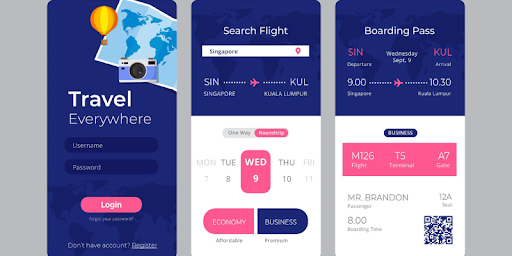The travel industry has experienced a digital revolution, with mobile applications becoming the primary tool for travelers to plan, book, and manage their journeys.
From flight bookings to hotel reservations, travel apps have transformed how we explore the world.
However, the success of any travel application heavily depends on choosing the right development framework—a decision that can significantly impact performance, scalability, user experience, and development costs.
Process to Select the Right Framework for Travel App Development
Selecting the appropriate framework is crucial because travel apps have unique requirements that differ from other mobile applications. They need to handle real-time data from multiple sources, function across various devices and platforms, integrate with numerous third-party services, and provide seamless offline capabilities.
The framework you choose will determine how effectively your app can meet these demands while delivering an exceptional user experience.
Step 1: Define Your Travel App Requirements
The first step in choosing the right framework is to clearly define your travel app’s requirements. Start by identifying your core features: Will your app focus on flight bookings, hotel reservations, travel planning, or all three? Do you need real-time updates for flight statuses and pricing? Will users need offline access to their booking confirmations and itineraries?
When you’re ready to create your customized app, develop a detailed implementation plan that includes development phases, testing strategies, and deployment timelines. Consider your target audience and their device preferences. Are you targeting business travelers who primarily use iOS devices, or budget-conscious travelers who might prefer Android?
Understanding your user base will help determine whether you need native apps for specific platforms or can leverage cross-platform solutions.
Evaluate your technical requirements carefully. Travel apps typically need GPS integration for location-based services, camera access for document scanning, push notifications for flight updates, and secure payment processing. List all the device features and third-party integrations your app will require, as this will significantly influence your framework choice.
Step 2: Assess Your Budget and Timeline Constraints
Your budget and timeline play a crucial role in framework selection. Native development for both iOS and Android requires separate development teams and longer timelines, potentially doubling your development costs. If you have limited resources, cross-platform frameworks can significantly reduce both time and cost while still delivering quality results.
Calculate not just the initial development costs but also ongoing maintenance expenses. Native apps require separate updates for each platform, while cross-platform solutions allow you to maintain a single codebase. Consider the long-term implications of your choice, including future feature additions and platform updates. This can increase the total cost to develop a travel app.
Factor in your go-to-market strategy. If you need to launch quickly to capitalize on market opportunities, cross-platform frameworks might be more suitable. However, if you’re building a premium travel app where performance is paramount, the additional investment in native development might be justified.
Step 3: Evaluate Your Team’s Technical Expertise
Assess your development team’s skills and experience. If your team has strong JavaScript and React experience, React Native would be a natural choice. Teams with Java or C# backgrounds might prefer Xamarin, while those comfortable with Dart should consider Flutter.
Consider the learning curve for different frameworks. While your team might be capable of learning new technologies, the time investment required for mastery could impact your project timeline. Evaluate whether it’s more cost-effective to train your existing team or hire specialists for your chosen framework.
Don’t forget to consider the availability of skilled developers in your region. Some frameworks have larger talent pools than others, which could affect both hiring costs and project timelines. Research the local market for developers experienced in your preferred framework.
Step 4: Analyze Platform-Specific Requirements
Examine the specific requirements for each platform you plan to target. iOS apps benefit from native development when they need deep integration with Apple services like Apple Pay, HealthKit, or Core Location. Android apps might require specific Google Services integration or access to unique Android features.
Consider platform-specific design guidelines. iOS follows Human Interface Guidelines, while Android adheres to Material Design principles. Some cross-platform frameworks handle these differences automatically, while others require manual customization to achieve platform-native appearances.
Evaluate app store requirements and submission processes. Native apps generally have smoother app store approval processes, while some cross-platform solutions might face additional scrutiny or requirements during submission.
Step 5: Research Framework Options and Capabilities
Conduct thorough research on available frameworks and their capabilities. For native development, iOS offers Swift and Objective-C, while Android provides Java and Kotlin. These options offer maximum performance and complete access to platform features but require separate development efforts.
React Native allows you to write once and deploy to both platforms, making it popular for travel apps. It offers good performance, extensive third-party library support, and the ability to incorporate native modules when needed. Many successful travel apps like Airbnb have used React Native effectively.
Flutter, Google’s relatively new framework, compiles to native code and offers excellent performance. It provides rich UI components and smooth animations, making it suitable for travel apps with complex interfaces. However, it has a smaller ecosystem compared to React Native.
Xamarin allows sharing up to 90% of code between platforms while maintaining native performance. It’s particularly suitable for enterprises already invested in Microsoft technologies and offers excellent integration with Azure cloud services.
Step 6: Consider Third-Party Integrations and APIs
Travel apps heavily rely on third-party integrations, so evaluate how well different frameworks support the APIs and services you’ll need. Research the availability of libraries and plugins for popular travel APIs like Amadeus, Sabre, or Expedia Partner Network.
Payment integration is crucial for travel apps. Assess how easily different frameworks can integrate with payment processors like Stripe, PayPal, and region-specific payment methods. Consider the security implications and ensure your chosen framework supports necessary compliance requirements.
Mapping and location services are fundamental to travel apps. Evaluate how well different frameworks work with Google Maps, Apple Maps, and other location-based services. Consider the availability of navigation libraries, geolocation APIs, and offline mapping capabilities.
Step 7: Prototype and Test Performance
Before making a final decision, create prototypes using your shortlisted frameworks. Build simple versions of your app’s core features and test them on real devices. This hands-on approach will give you valuable insights into each framework’s performance, development experience, and potential challenges.
Test your prototypes with real data loads similar to what your production app will handle. Travel apps often need to display large amounts of dynamic content, so ensure your chosen framework can handle this efficiently without performance degradation.
Evaluate the development experience during prototyping. Consider factors like debugging capabilities, development tools, documentation quality, and community support. A framework with excellent development tools can significantly improve your team’s productivity.
Step 8: Plan for Scalability and Future Growth
Consider your app’s future growth and scalability requirements. Will you need to add new features regularly? Do you plan to expand to new platforms or integrate with additional services? Choose a framework that can accommodate your long-term vision without requiring major rewrites.
Evaluate the framework’s update frequency and backward compatibility. Regular updates indicate active development and security improvements, but frequent breaking changes can increase maintenance overhead. Look for frameworks with stable APIs and clear upgrade paths.
Consider the framework’s performance under load. Travel apps often experience traffic spikes during peak booking seasons or major travel events. Ensure your chosen framework can handle increased user loads without compromising performance.
Step 9: Consult with Development Experts
When working with a travel app development company, leverage their expertise in framework selection. Experienced developers can provide valuable insights into the pros and cons of different frameworks based on real-world project experience.
Seek advice from developers who have specifically worked on travel apps. They can share insights about common challenges, performance bottlenecks, and successful implementation strategies. Their experience can help you avoid potential pitfalls and make informed decisions.
Consider getting multiple opinions from different development teams or consultants. Different perspectives can help you identify considerations you might have missed and validate your framework choice.
Step 10: Make the Final Decision and Create an Implementation Plan
After completing your evaluation process, make your final framework decision based on all the gathered information. Document your decision rationale, including the factors that influenced your choice and any trade-offs you accepted.
Consider how your chosen framework will affect each phase of development and plan accordingly.
Establish success metrics for your framework choice. Define measurable criteria for performance, user experience, and development efficiency that will help you evaluate whether your framework decision was correct.
Conclusion
Choosing the right framework for travel app development is a critical decision that requires careful consideration of multiple factors. By following this systematic process—from defining requirements to consulting with experts—you can make an informed choice that aligns with your project goals, budget, and timeline.
Remember that there’s no universally “best” framework; the right choice depends on your specific circumstances and requirements. Focus on finding the framework that best matches your needs and can deliver a reliable, secure, and engaging travel experience for your users.
The key to success lies not just in choosing the right framework, but in executing your development plan effectively and maintaining focus on creating value for your users throughout the development process.


